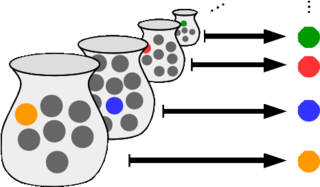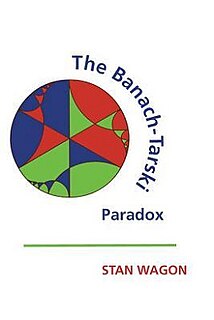
In mathematics, the axiom of choice, or AC, is an axiom of set theory equivalent to the statement that a Cartesian product of a collection of non-empty sets is non-empty. Informally put, the axiom of choice says that given any collection of bins, each containing at least one object, it is possible to make a selection of exactly one object from each bin, even if the collection is infinite. Formally, it states that for every indexed family of nonempty sets there exists an indexed family of elements such that for every . The axiom of choice was formulated in 1904 by Ernst Zermelo in order to formalize his proof of the well-ordering theorem.
The Hahn–Banach theorem is a central tool in functional analysis. It allows the extension of bounded linear functionals defined on a subspace of some vector space to the whole space, and it also shows that there are "enough" continuous linear functionals defined on every normed vector space to make the study of the dual space "interesting". Another version of the Hahn–Banach theorem is known as the Hahn–Banach separation theorem or the hyperplane separation theorem, and has numerous uses in convex geometry.

Measure is a fundamental concept of mathematics. Measures provide a mathematical abstraction for common notions like mass, distance/length, area, volume, probability of events, and — after some adjustments — electrical charge. These seemingly distinct concepts are innately very similar and may, in many cases, be treated as mathematically indistinguishable. Measures are foundational in probability theory. Far-reaching generalizations of measure are widely used in quantum physics and physics in general.
Christopher Francis Freiling is a mathematician responsible for Freiling's axiom of symmetry in set theory. He has also made significant contributions to coding theory, in the process establishing connections between that field and matroid theory.
In the mathematical discipline of general topology, a Polish space is a separable completely metrizable topological space; that is, a space homeomorphic to a complete metric space that has a countable dense subset. Polish spaces are so named because they were first extensively studied by Polish topologists and logicians—Sierpiński, Kuratowski, Tarski and others. However, Polish spaces are mostly studied today because they are the primary setting for descriptive set theory, including the study of Borel equivalence relations. Polish spaces are also a convenient setting for more advanced measure theory, in particular in probability theory.

In mathematics, a fixed point of a function is an element of the function's domain that is mapped to itself by the function. That is to say, c is a fixed point of the function f if f(c) = c. This means f(f ) = f n(c) = c, an important terminating consideration when recursively computing f. A set of fixed points is sometimes called a fixed set.

In mathematics, an extreme point of a convex set S in a real vector space is a point in S which does not lie in any open line segment joining two points of S. In linear programming problems, an extreme point is also called vertex or corner point of S.
Lists of mathematics topics cover a variety of topics related to mathematics. Some of these lists link to hundreds of articles; some link only to a few. The template to the right includes links to alphabetical lists of all mathematical articles. This article brings together the same content organized in a manner better suited for browsing. Lists cover aspects of basic and advanced mathematics, methodology, mathematical statements, integrals, general concepts, mathematical objects and reference tables. They also cover equations named after people, societies, mathematicians, journals and meta-lists.
In mathematics, a non-measurable set is a set which cannot be assigned a meaningful "volume". The mathematical existence of such sets is construed to provide information about the notions of length, area and volume in formal set theory. In Zermelo–Fraenkel set theory, the axiom of choice entails that non-measurable subsets of exist.

Grigory Aleksandrovich Margulis is a Russian-American mathematician known for his work on lattices in Lie groups, and the introduction of methods from ergodic theory into diophantine approximation. He was awarded a Fields Medal in 1978, a Wolf Prize in Mathematics in 2005, and an Abel Prize in 2020, becoming the fifth mathematician to receive the three prizes. In 1991, he joined the faculty of Yale University, where he is currently the Erastus L. De Forest Professor of Mathematics.
In functional analysis and related areas of mathematics, a barrelled space is a topological vector space (TVS) for which every barrelled set in the space is a neighbourhood for the zero vector. A barrelled set or a barrel in a topological vector space is a set that is convex, balanced, absorbing, and closed. Barrelled spaces are studied because a form of the Banach–Steinhaus theorem still holds for them. Barrelled spaces were introduced by Bourbaki (1950).
In mathematics, signed measure is a generalization of the concept of measure by allowing it to have negative values. In the theory of measures a signed measure is sometimes called a charge.
Network coding is a field of research founded in a series of papers from the late 1990s to the early 2000s. However, the concept of network coding, in particular linear network coding, appeared much earlier. In a 1978 paper, a scheme for improving the throughput of a two-way communication through a satellite was proposed. In this scheme, two users trying to communicate with each other transmit their data streams to a satellite, which combines the two streams by summing them modulo 2 and then broadcasts the combined stream. Each of the two users, upon receiving the broadcast stream, can decode the other stream by using the information of their own stream.

Matthew Dean Foreman is an American mathematician at University of California, Irvine. He has made notable contributions in set theory and in ergodic theory.
The Banach–Tarski paradox is a theorem in set-theoretic geometry, which states the following: Given a solid ball in 3‑dimensional space, there exists a decomposition of the ball into a finite number of disjoint subsets, which can then be put back together in a different way to yield two identical copies of the original ball. Indeed, the reassembly process involves only moving the pieces around and rotating them without changing their shape. However, the pieces themselves are not "solids" in the usual sense, but infinite scatterings of points. The reconstruction can work with as few as five pieces.
In mathematics, Ingleton's inequality is an inequality that is satisfied by the rank function of any representable matroid. In this sense it is a necessary condition for representability of a matroid over a finite field. Let M be a matroid and let ρ be its rank function, Ingleton's inequality states that for any subsets X1, X2, X3 and X4 in the support of M, the inequality

The Banach–Tarski Paradox is a book in mathematics on the Banach–Tarski paradox, the fact that a unit ball can be partitioned into a finite number of subsets and reassembled to form two unit balls. It was written by Stan Wagon and published in 1985 by the Cambridge University Press as volume 24 of their Encyclopedia of Mathematics and its Applications book series. A second printing in 1986 added two pages as an addendum, and a 1993 paperback printing added a new preface. In 2016 the Cambridge University Press published a second edition, adding Grzegorz Tomkowicz as a co-author, as volume 163 of the same series. The Basic Library List Committee of the Mathematical Association of America has recommended its inclusion in undergraduate mathematics libraries.
This is a glossary for the terminology in a mathematical field of functional analysis.







